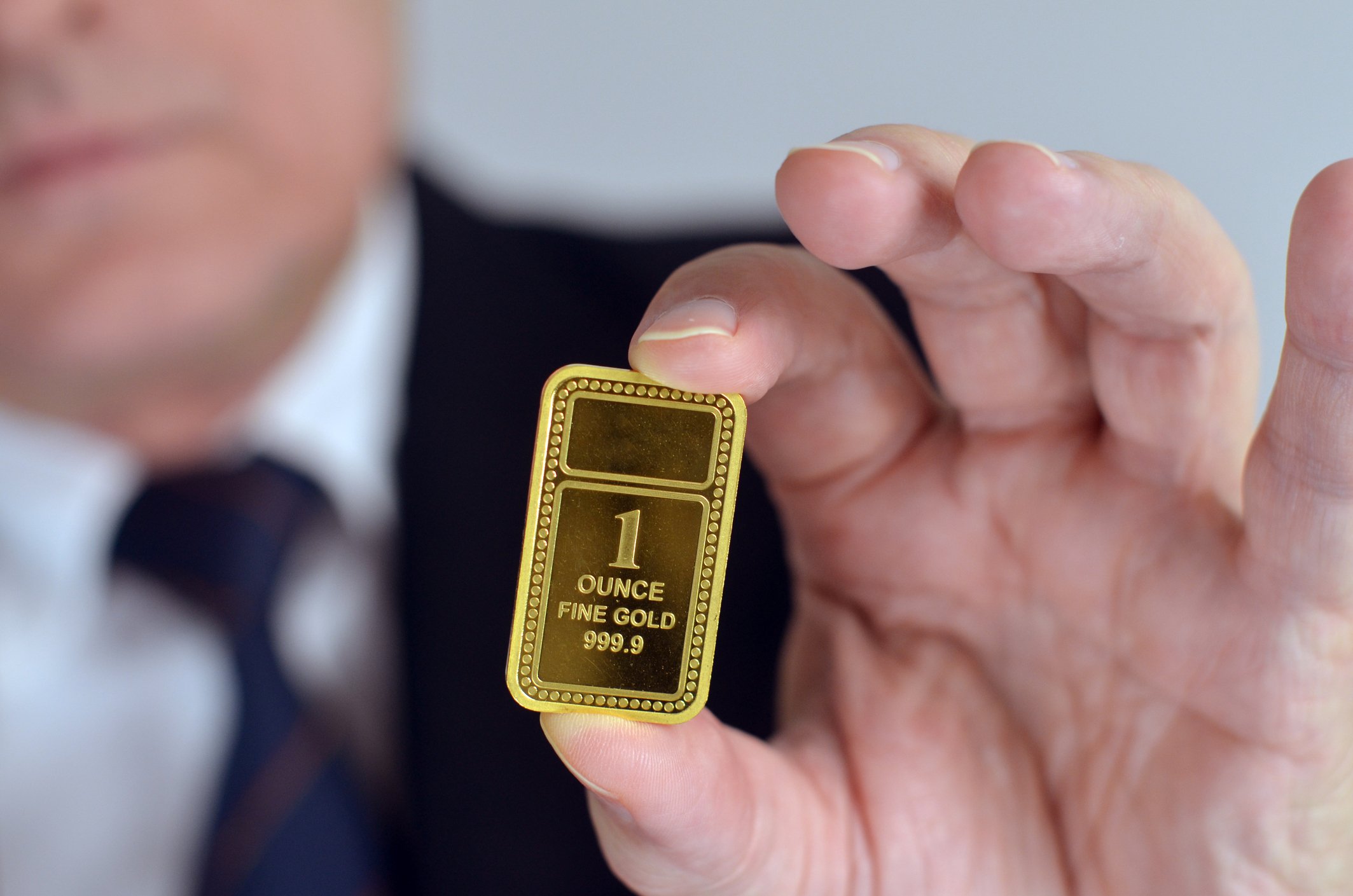The current bull market is one of the longest on record. It doesn't have to end, but history suggests that every bull market will eventually be followed by a bear market. That's a sobering thought that should lead investors to at least consider some safe-haven investments. One of the most iconic safe havens is gold. But how do you buy this precious metal? Here are three different ways, and three precious-metal stocks that should be on your radar today.
All that glitters...
There are a few main ways to get exposure to gold. The most obvious is to simply go out and buy some. That doesn't mean buy a gold necklace; jewelry markups are huge, and it's generally a terrible way to invest in gold. But you can buy gold bullion and coins. You'll likely face markups here, too, since your coin dealer will want to be compensated, but it won't be as bad as jewelry.

Image source: Getty Images
The problem is that gold has no growth potential -- an ounce of gold will always be an ounce of gold. The only upside will come from higher gold prices. And unless you expect the world financial system to collapse, there's little benefit to direct ownership of the metal. Exchange traded funds (ETFs) that invest directly in gold are roughly similar, but easier to buy and sell.
In the end, however, many investors prefer to invest in precious-metal miners. The benefit of this is that miners can expand their operations, thus providing an opportunity for growth. A key problem here, though, is that miners have to deal with the costs and risks of actually operating a mine. And some simply do a better job than others. It's not a bad plan to own a gold miner, but there's a potentially better option: a streaming and royalty company.
These companies, including industry heavyweights Wheaton Precious Metals (NYSE: WPM), Royal Gold (RGLD +0.73%), and Franco-Nevada (FNV +0.73%), don't operate any mines. They provide miners with upfront cash in exchange for the right to buy gold, silver, and other commodities at reduced rates in the future. Miners use the cash to build mines, expand existing assets, or to strengthen their balance sheets, while the streaming companies benefit from contractually locked-in low prices. For example, Wheaton paid roughly $400 per ounce of gold in 2018 -- well below the spot price of the yellow metal.
That said, these three streaming companies have very different operations. Here's a quick lowdown on each one.
1. Variable is, maybe, good
Wheaton has a somewhat unique focus in the streaming world. It prefers to invest in a smaller number of large mine streams. It currently has investments in 19 operating mines and nine development projects. This limits the company's diversification, increasing the risk that a disruption at a single mine investment could hit its top and bottom lines. (If a mine isn't producing gold or silver, a streaming company will have nothing to buy.)
Overall, that hasn't been too big an issue. But there are two other factors that are notable. First is that Wheaton had historically been focused on silver, only recently shifting to a more balanced approach. Today, gold and silver are roughly evenly split in the portfolio. And it has also started to add other metals, including palladium and cobalt. (This stream hasn't yet begun because the mine is still being developed.) All in, however, it probably provides the most balanced mix between gold and silver.
FNV Dividend Per Share (Annual) data by YCharts
The other unique feature at Wheaton is its variable dividend policy. The company sets the dividend at 30% of the average cash generated by operations over the trailing 12 months. Paid out on a per share basis, the result is that when Wheaton is making more money, investors get paid larger dividends. When Wheaton makes less money, investors get less in dividends. For investors seeking a steady stream of income, that would be horrible, but step back and think about this for a moment.
Gold and silver often perform best when the stock market is performing poorly, the driving force being investors switching to investments, like precious metals, which are viewed as a store of wealth. That means that not only is Wheaton's stock likely to be rising when the rest of your portfolio is getting hit, but it will also be spitting out an increasing amount of cash right when you'll be needing something to calm your investing nerves. The current yield is around 1.5%.
2. An incredible streak
In some ways, Royal Gold is way more diversified than Wheaton, having 191 investments in its portfolio. While only 41 are producing today, there are 17 in development and 133 in some earlier stage. Those numbers dwarf Wheaton's portfolio. That said, gold makes up roughly 70% of its production (a recent silver stream acquisition pushed that down from around 75%), with silver rounding out its precious-metal production to 85% of the total. The rest is copper and other metals. Of the trio here, it is the most exposed to gold.
The second big differentiating factor is Royal Gold's dividend. It has been increased for an incredible 18 consecutive years. That's notable not only because it's longer than its peers, but also because precious metals are notoriously volatile. To be fair, the yield is a modest 1.2% today, so it is hard to consider Royal Gold an income stock. But management has clearly demonstrated that it considers it important to return value to shareholders via increasing dividend payments. For income investors seeking out gold exposure, Royal Gold could be a very good fit.
3. Far more diversified
Out of this trio, Franco-Nevada easily has the most diversified portfolio. It has 51 producing mines, 37 in advanced exploration, and 202 in earlier stages. In addition to that, it has investments in 55 oil and natural gas drilling projects and another 25 energy exploration projects. In total, Franco-Nevada has 370 investments in its portfolio. This is a mixed blessing for investors looking at gold, since this streaming company is far from a pure play on the metal. In 2018, Franco-Nevada's precious-metal business had a weak year, and the oil and gas investments were able to pick up the slack. That might interest those who view diversification as a good thing.
That said, Franco-Nevada's goal is to generate 80% of revenue from precious metals. That ebbs and flows over time, with the figure currently in high-80% range. It's expected to drop into the mid- to low-80% area over the next five years as its current slate of oil investments starts to bear fruit. But Franco-Nevada will still largely be a precious-metal investment, with a side of energy.
Like Royal Gold, Franco-Nevada considers dividends an important form of return. It has increased its dividend every year for 11 consecutive years. The current yield is roughly 1.3%. For investors who want to hedge their bets a little, Franco-Nevada's energy exposure could give it the edge over Royal Gold and Wheaton.
A trio of great options
To be honest, Wheaton, Royal Gold, and Franco-Nevada are all well-run companies. Any one of them would be a good option for investors seeking to add some precious-metal exposure to their portfolio. Still, they each come with subtle differences that might make one a better pick over the others for you. If you are seeking a balance between gold and silver, Wheaton wins, noting, of course, that it has a variable dividend policy. If you prefer to get as much gold exposure as possible, then the best option is probably Royal Gold. And if you want diversification, then Franco-Nevada, which has some energy in the mix, could be the best way to go.









